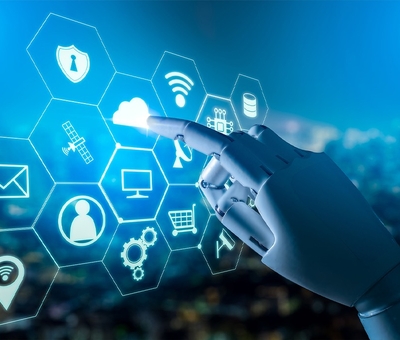
ENHANCING USER EXPERIENCE THROUGH AI
AI-powered web design leverages artificial intelligence (AI) algorithms to enhance user experience (UX) on websites. By analyzing user behavior, preferences, and interactions, AI can personalize content, streamline navigation, and optimize layout and design elements in real-time. This results in a more tailored and engaging browsing experience for users, ultimately leading to increased satisfaction, retention, and conversions on websites.
AI-powered web design integrates artificial intelligence (AI) algorithms to enhance user experience (UX) on websites. By analyzing user behavior, preferences, and interactions, AI tailors content, streamlines navigation, and optimizes layout and design elements in real-time, creating a more engaging browsing experience.
AI's impact on web design is profound. It enables personalized experiences by dynamically adapting content based on individual user preferences and past interactions. For example, AI algorithms can recommend products, articles, or services based on a user's browsing history, demographics, or location.
Furthermore, AI-powered chatbots enhance customer support by providing instant assistance and resolving queries efficiently. These chatbots use natural language processing (NLP) to understand and respond to user inquiries, offering a seamless customer service experience.
AI also plays a crucial role in optimizing website performance. Through machine learning algorithms, AI analyzes data to identify patterns and trends in user behavior. This data-driven approach enables web designers to make informed decisions about layout, design elements, and content placement, ultimately improving user engagement and conversion rates.
Another significant application of AI in web design is automated testing and optimization. AI algorithms can conduct A/B tests, multivariate tests, and other experiments to identify the most effective design variations for achieving specific goals, such as increasing click-through rates or reducing bounce rates. This iterative process of testing and optimization ensures that websites continuously evolve to meet user needs and preferences.
Additionally, AI-driven design tools assist web designers in creating visually appealing and user-friendly interfaces. These tools use generative design techniques to generate layout suggestions, color schemes, and typography options based on user input and design principles. This streamlines the design process and empowers designers to create professional-looking websites more efficiently.
Despite its numerous benefits, AI-powered web design also poses challenges and considerations. One concern is the ethical use of AI, particularly in areas such as data privacy and algorithmic bias. Web designers must ensure that AI algorithms comply with privacy regulations and mitigate biases that may perpetuate discrimination or exclusion.
Moreover, AI requires access to large datasets for training and continuous improvement. Web designers must prioritize data security and consider the implications of collecting and processing user data for AI-driven features.
In conclusion, AI-powered web design revolutionizes the way websites are created and experienced. By leveraging AI algorithms for personalization, optimization, and automation, web designers can deliver tailored, high-performing websites that engage users and drive conversions effectively. However, ethical considerations and data privacy concerns underscore the importance of responsible AI implementation in web design.
